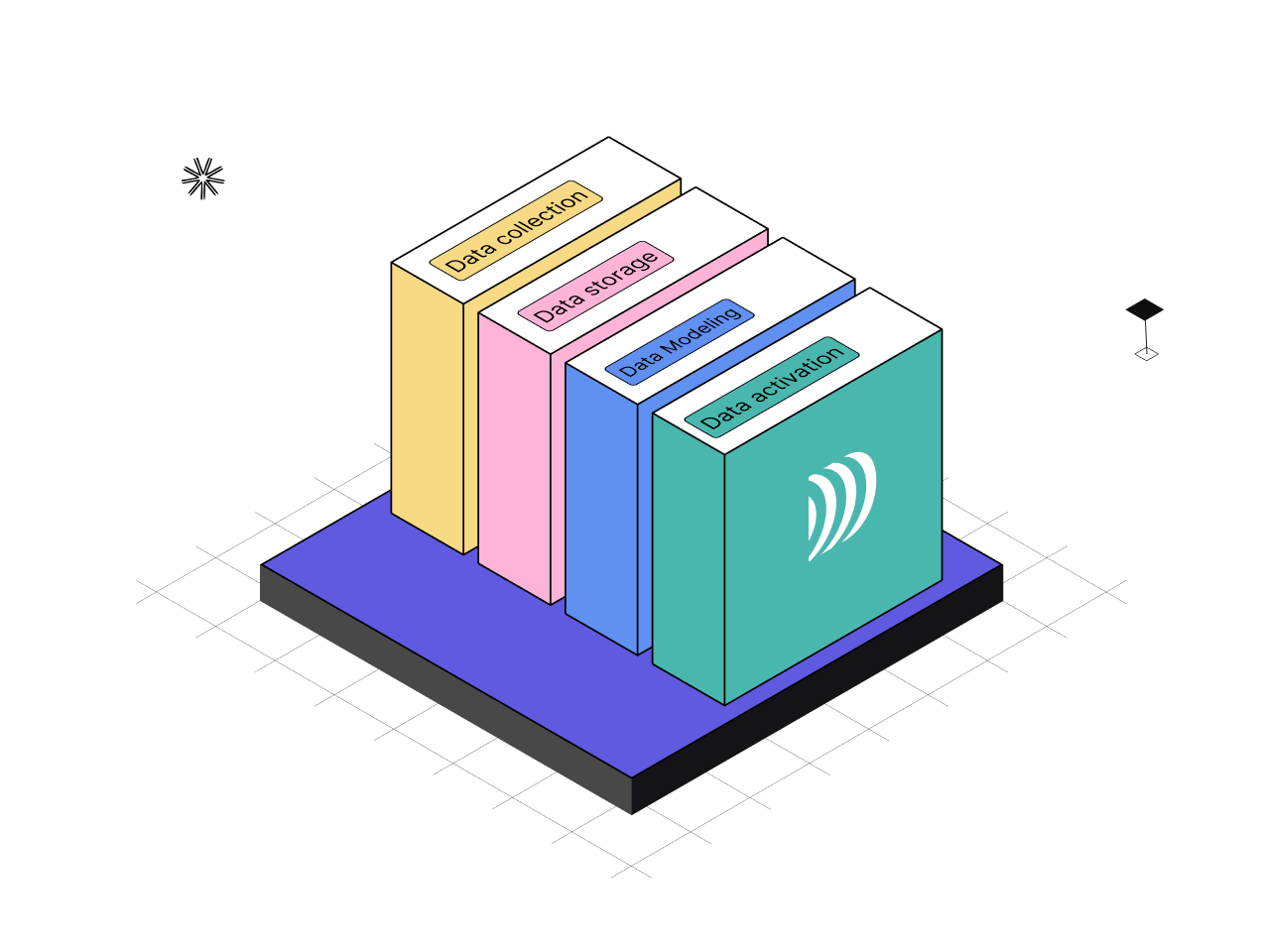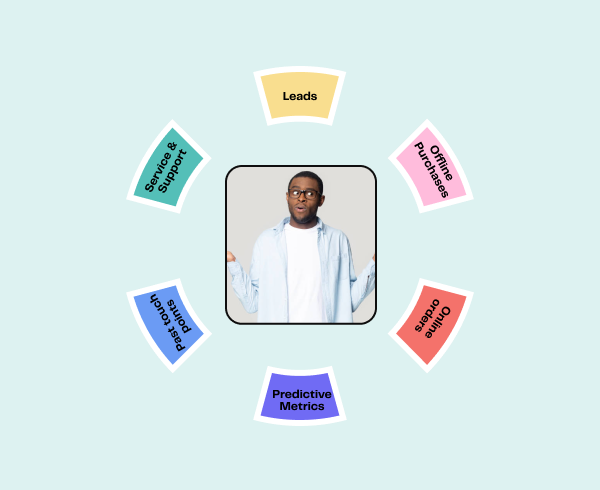
Customer 360: definition and use cases
6min • Last updated on Mar 27, 2025

Alexandra Augusti
Chief of Staff
Building or adopting a Customer 360 involves choosing a strategy to gain a comprehensive and integrated view of each customer by collecting and aggregating data from multiple sources, without being limited to a single platform or system.
This complete perspective empowers companies to better understand the needs, preferences, and behaviors of consumers, allowing them to provide tailored and high-quality experiences.
Several tools enable obtaining one's own Customer 360. This includes Customer Data Platforms, which are specifically designed to build, manage, and activate unified customer profiles.
In this article, we detail:
What a Customer 360 is
What are the benefits of Customer 360
How a Customer 360 works
What are the tools that enable obtaining and managing customer data
What is Customer 360?
Customer 360 is a comprehensive approach aimed at building a 360-degree and exhaustive view of each customer.
It involves gathering data from various sources, without relying on a single platform or system.
It at least encompasses transactional information and demographic profiles, while being able to integrate additional (customer support, social media interactions, and other relevant data) or enriched data (predictions through artificial intelligence, for example) for a better understanding of the customer.
Customer 360 provides an integrated view of the customer journey, from the first contact to their loyalty, enabling tracking changes in their needs, expectations, and behaviors over time. Through this, it is possible to offer a total omnichannel experience and personalised products and services at each stage of this journey.
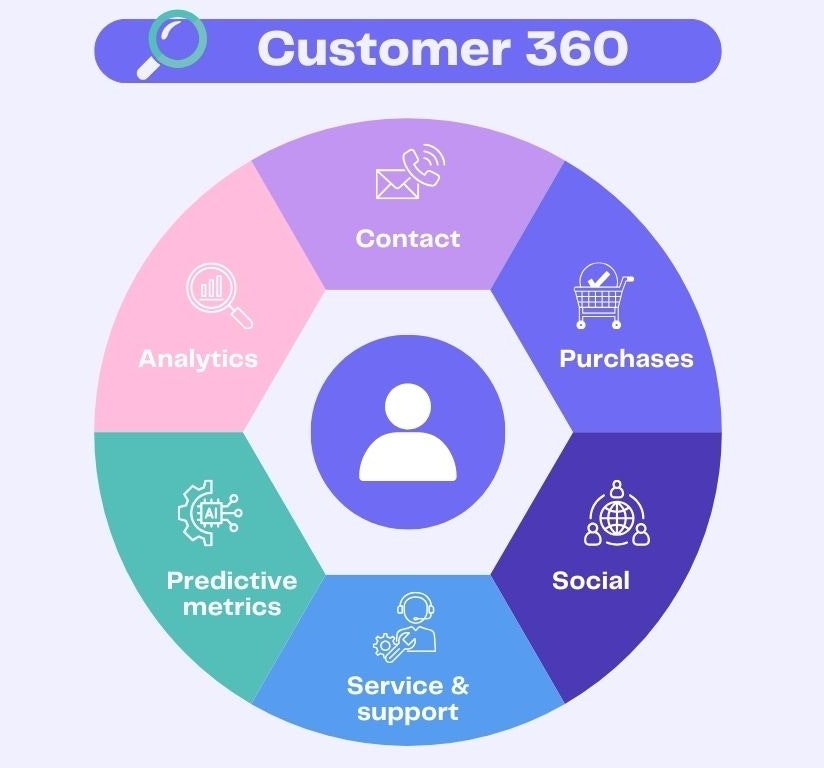
Customer 360
What are the benefits of Customer 360?
Customer 360 goes beyond simply collecting customer data to become an essential strategic tool for optimising performance and customer satisfaction. Here's why it is crucial for businesses:
It provides enhanced customer knowledge, accessible to all teams (marketing, sales, support, etc.), ensuring that everyone is working from a single source of truth.
This allows for effective customer segmentation, predicting their behaviors, anticipating customer loss risk (to limit the churn rate), as well as accurately measuring their satisfaction and loyalty.
It ensures a seamless and personalised omnichannel customer experience. Customer 360 ensures harmony and continuity across various touchpoints, digital or physical. Companies can offer services and products tailored to individual customer expectations, based on their history, context, and preferences, consistently across all activated channels.
It boosts operational efficiency by automating and optimising customer processes (marketing, sales, customer service, billing, etc.), leading to time and cost savings. Internal collaboration is improved by eliminating redundancies, errors, and conflicts.
It enhances customer service management. With a 360-degree view of information and customer query history, companies can provide fast and high-quality service. Personalising service based on each customer's profile, journey, and value allows for more adequate responses to their needs.
It allows for effective data management, ensuring constant data updates for real-time decisions based on accurate data. Customer 360 promotes centralised, cleaned, standardised, enriched, and secure customer data. It avoids information silos and facilitates compliance, while allowing in-depth analysis and the creation of relevant dashboards to guide business strategy.
Besides analytics, Customer 360 can be used in a number of ways, by marketing, sales, product and support teams. It could be used to increase conversions, reduce the churn rate, improve Customer lifetime value (CLV), eliminating common friction points, and lots more.
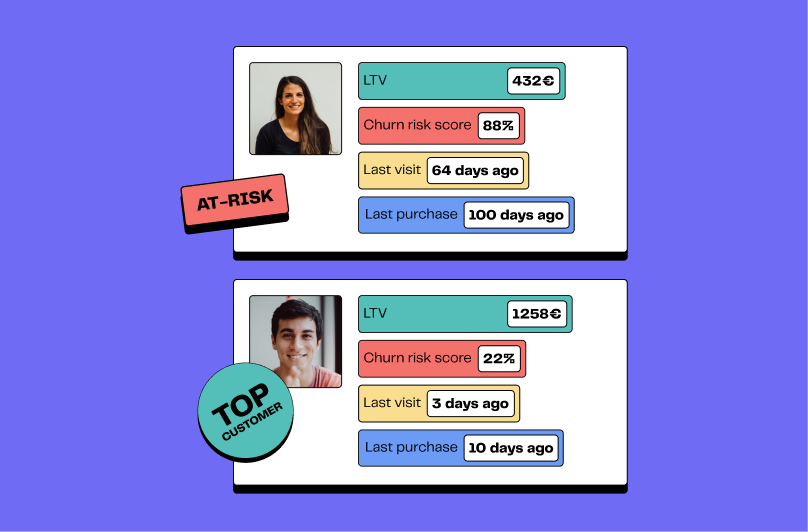
Customer 360: identifying At-risk and Top Customers
With a Customer 360 view, businesses can create highly targeted marketing campaigns based on individual customer preferences and behavior patterns.
Sales teams can use insights from Customer 360 to identify high-value customers, better segment their customer data base and tailor their approaches to increase conversion rates.
Moreover, understanding customer needs and feedback through a 360-degree view can inform product development and help the support team to better respond to customer needs.
Key steps and components of a unified customer view
Building a Customer 360 goes beyond simply gathering data in a single database. It involves a process enriched by several key stages and essential components, detailed as follows:
Data Collection: Crucial first step aiming to collect and consolidate customer data from multiple sources, including but not limited to CRM systems, marketing automation tools, sales systems, financial transactions, customer interactions, and social media presence. It is essential to identify all the data that needs to be collected to address all identified CDP-like use cases (e.g. event data, clickstream data or general data from SaaS applications).
Data Ingestion: This step involves incorporating the collected data into a unified database or central warehouse, for instance, a data warehouse. This base acts as a convergence point for all customer information, ensuring simplified accessibility to their interactions, preferences, and histories. It essentially eliminates data silos to provide a 360-degree customer view.
Data Preparation: Next comes the data cleaning and validation phase to ensure accuracy and consistency. The process usually includes removing duplicates, correcting errors, and standardising formats. It’s about making the customer data usable for anyone. At this stage, the customer profile is often enriched with external data, such as additional demographic information or social media activities, providing a deeper perspective on each customer. It is also possible to add predictive attributes through the use of artificial intelligence. At DinMo, we add various metrics, such as expected additional CLV, churn risk, or the Next Best Offer.
🛍 See our case study with Galeries Lafayette to learn more about our predictive attributes.
Identity Resolution: Finally, the last major step identifies and links customer identities across different platforms to offer a unified customer view (usually through matching different identifiers), encompassing all touch points with the company.
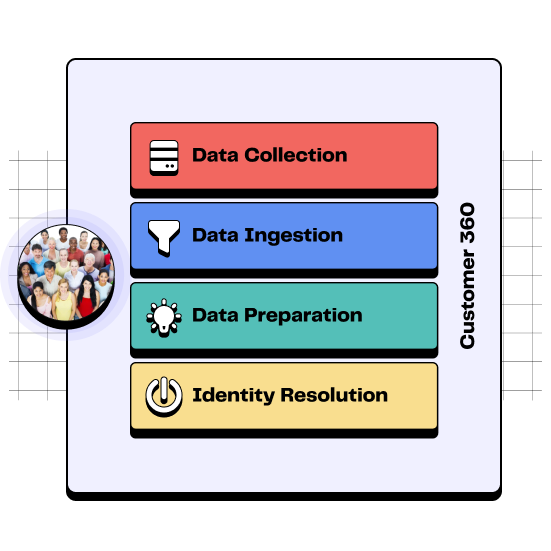
Customer 360 components
💡 The main blockers to getting started with Customer 360 often are “Data preparation” and “Identity Resolution” as it may require technical skills.
How to obtain your own Customer 360?
Acquiring your personalised Customer 360 depends on the specifics of your company, including your needs, resources, and objectives.
Businesses can adopt traditional CDPs, create custom solutions, or opt for composable CDP solutions leveraging cloud data warehouses:
Option 1: Adopt a traditional CDP or SaaS tool
Customer Data Platforms (CDPs) centralise, clean, and analyse customer data from multiple sources. The market offers a multitude of traditional CDPs. Despite their benefits, they can incur significant costs, and especially limit customisation, as the data model behind their "Customer 360" is not flexible.
Packaged CDPs also raise questions about integration with other systems and constraints related to security, compliance, or performance. These “black box” operate within their own realm and restrict you on how you can manipulate your own data.
⚠️ CRM is not recommended either, because it does not contain all the information (transactional, product, behavioral, etc.) and, above all, it imposes rigid data schemas.
Option 2: Create your own Customer 360
This path involves using available tools and technologies, including databases, ETL, APIs, or open-source frameworks, to build a custom Customer 360. While it offers great control over data and processes, this option requires a considerable investment in time, skills, and resources.
It also exposes challenges such as data quality management, security, and scalability.
Option 3: Opt for a Composable CDP solution, known as "data warehouse native"
Composable solutions enable the development of your Customer 360 by leveraging your cloud data warehouse, the company's centralised database. They combine the operational simplicity of CDPs and the customisation of bespoke solutions, relying on the robustness, security, and performance of the data warehouse.
Additionally, they facilitate key features such as collecting, integrating, preparing, and identifying customer data. By building a custom and centralised repository for their data, operational teams can gain deeper insights into their customers, improve their collaboration with other departments, improve their ROI, and improve their overall efficiency. In today's hyper-competitive business environment, these benefits are more important than ever. By turning their own cloud data warehouse into a real Customer 360, marketing teams can position themselves for success in the years to come.
Conclusion
Adopting Customer 360 is a crucial strategy for companies looking to have a complete and integrated view of their customers. This approach merges customer information from multiple sources. It offers undeniable benefits: a deep understanding of customers, a consistent user experience across all channels, operational optimisation, improved customer service, and more efficient data management.
DinMo is at the forefront of the next generation of Customer Data Platforms with its Composable CDP. We enable marketing teams to build their Customer 360 in just a few minutes, without any technical constraints. For more information about DinMo, contact us!














